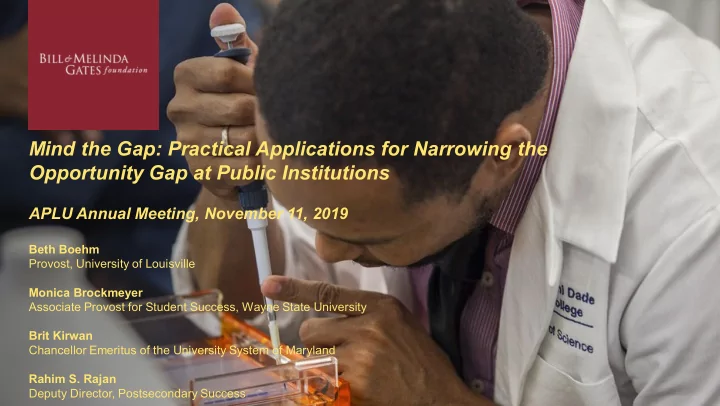

Mind the Gap: Practical Applications for Narrowing the Opportunity Gap at Public Institutions APLU Annual Meeting, November 11, 2019 Beth Boehm Provost, University of Louisville Monica Brockmeyer Associate Provost for Student Success, Wayne State University Brit Kirwan Chancellor Emeritus of the University System of Maryland Rahim S. Rajan Deputy Director, Postsecondary Success
We believe that every person deserves the chance to lead a healthy, productive life. In the U.S., this means expanding life-changing opportunities, including –and especially– education.
We work with partners to expand opportunity by: Increasing the number of students achieving certificates and degrees Closing gaps in student success by race and income
THE VALUE OF COLLEGE Opportunity in the United States is not attainable without postsecondary education today. Lifetime Income Distribution of 100 Children Born into Poverty (Bottom Income Quintile) Did Not Attend College (100) Attended College (100) 5 1 Top 4 Quintile: 9 Richest 20% 4 2 9 2 3 1 2 7 3 2 2 2 8 1 1 4 1 2 5 Source: Chetty, Raj, et al. “The Fading American Dream: Trends in Absolute Income Mobility Since 1940.” Opportunity Insights, Dec. 2016; “Race and Economic Opportunity in the United States: An Intergenerational Perspective.” Opportunity Insights, March 2018; “Mobility Report Cards: The Role of Colleges in Intergenerational Mobility.” Opportunity Insights, July 2017. 4 Postsecondary Value Commission
November 20, 2019 EDUCATIONAL ATTAINMENT & COMPLETION GAPS Gaps by race/ethnicity and income limit equitable access to economic mobility Attainment (% w/ AA+) for working-age Completion Rates by Race/Ethnicity (2017) adults (25-64) by Race/Ethnicity (2017) 64% 64% Asian Asian 46% White non-Hispanic White non-Hispanic 54% 42% National Average 48% National Average Latinx 31% 42% AI/AN Pacific Islander 30% 40% Black/AA Black/AA 29% 31% Pacific Islander Latinx 22% AI/AN 31% Estimated Bachelor’s attainment by age 24 Completion Rates by Pell/Loan Status by Income Quartile (2017) (2017) Highest income quartile 62% 57% Non-Pell Recipients 3 rd income quartile 47% 38% 2 nd income quartile Pell Recipients 20% 13% Lowest income quartile Attainment: U.S. Census Bureau (2017). Educational Attainment , 2013-2017 American Community Survey 5-year estimates . Estimated Attainment : Cahalan, M., Perna, L. W., Yamashita, M., Wright-Kim, J. & Jiang, N. (2019). 2019 Indicators of Higher Education Equity in the United States: Historical Trend Report. Washington, DC: The Pell Institute for the Study of Opportunity in Higher Education. Completion Rates : IPEDS (2017) Graduation Rate Surveys. Includes Title-IV, degree-granting institutions in the US 50 States. Completion is measured at 150% of normal time and includes any completion type. 5 Loss & Momentum
OUR STRATEGY: INCREASING OPPORTUNITY AND MOBILITY Where We Are Where We Invest Where We Want to Be Low Increasing Student Success Student Success Rates Rates Innovation Digital Learning + + Technology-Enabled Advising Redesigned Remedial Courses Large Decreasing Gaps in Success Gaps in Success by Race and by Race and Income Income Transformation Policy Advocacy = = Institutional Partnerships Data and Information and Networks Finance/Financial Aid Less Mobility and More Mobility and Competitiveness Competitiveness 6 Bill & Melinda Gates Foundation
University of Louisville – Minding the Gap APLU Conference – November 11, 2019
Gradua uation R Rates 2 2012 E 12 Entering C Cohort* - 2018 G 18 Gradua uation Y Year Underprepared* (UP) Underfunded* (UF) N = 349 N = 855 * Students who are *Students who are Pell grant recipients not college-ready in one or more of the during year of entry following subjects: N = 156 N = 500 writing, reading, and 72 graduated N = 91 239 graduated mathematics (46%) 27 graduated (48%) (30%) N = 62 25 graduated (40%) N = 202 N = 40 105 graduated 21 graduated (52%) (52%) N = 184 119 graduated (65%) Overall University Cohort* 6-year Graduation Rate: 56.6% Underrepresented Minority* (URM) N = 488 *Students who self-identify as Black, American *First-time, Full-time, Baccalaureate Degree-seeking Students Indian or Alaskan Native, Hispanic or Latino, Native Hawaiian or Other Pacific Islander, and White students: N=2,037 of which 26.6% were Underfunded and 10.7% were Underprepared two or more races
Closing t the O Opportun unity G Gap: URM RM, U Underprepared, U Underfunded • Cultural Center: Dedicated Site for URM students, RSOs, Diversity Programming o Porter Scholars (1984): Largest scholarship for African-American students LLC Leadership training Dedicated Success Coaches o Black Male Initiative (2011) LLC Brothers United RSO Service and leadership development opportunities Dedicated Mentoring Program • TRIO for Low Income and First Generation o Dedicated Support Specialists o Study skills development and academic success workshops o Professional mentoring o Financial assistance/Financial literacy program • Adaptive Learning Courseware for Underprepared Students o Math: GEN 103/104 (APLU/Gates project) o Spring 2019 success rate 73.4% for white students, 73.3% for URM o Since 2016, 70% of students who completed GEN 103/104 passed their required math course
50% WSU 48% Graduation Rates 33% 2006-2008 2012-2013 (published 2010) (published 2017) 26% Educational Disparities (between White students and Black students) 32.5% 29.5%
Outcomes after only one year: 1 st to 2 nd year retention rate for Black VIP students who took First Year Seminar: 93% 1 st to 2 nd year retention rate for White students: 81% Monica Brockmeyer, Senior Associate Provost For Student Success mbrockmeyer@wayne.edu
FOLLOW US Postsecondary . gatesfoundation.org @GatesEd Bill & Melinda Gates Foundation
THANK YOU Be sure to rate this session in the app!
Recommend
More recommend